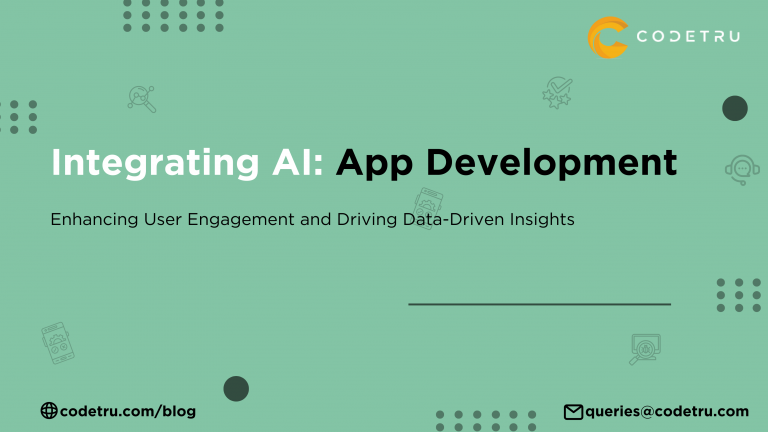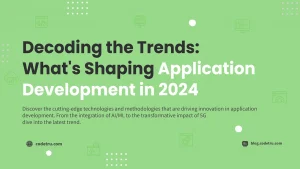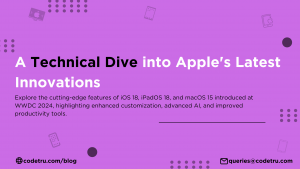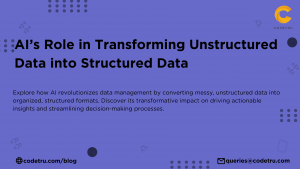In the dynamic realm of app development, Artificial Intelligence (AI) emerges as a transformative force, revolutionizing user experiences and reshaping functionalities. We delve into the intricacies of AI integration, its applications, and the journey to harness its potential for app enhancement.
AI is the embodiment of human intelligence within machines, enabling them to mimic cognitive functions like learning, language recognition, decision making, problem-solving etc. When integrated into app development, AI opens the door to creating smarter, more intuitive, and personalized user experiences.
How Can AI be Used in App Development
The fusion of AI and app development offers a diverse range of possibilities. But to start, you need to focus on the requirements for your app followed by tasks that can be automated or simplified using AI.
These are some of the things you can do to harness the power of AI and make your app development process swift-
-
Identify where AI can take-over Laying the groundwork begins with identifying specific challenges AI can address. Whether it’s improving user engagement, automating tasks, or enhancing recommendations, AI serves as a catalyst for innovative solutions. It can process a large amount of data, identify errors missed by human eye, or simply take the load off your shoulders.
-
Choose the right technology: Choosing the right technology can make your app development process hassle-free. You need to opt for the technology that aligns with your expectations, goals and app functionalities. The AI landscape encompasses machine learning, natural language processing, and computer vision, each suited for distinct purposes.
-
Data Collection: The most crucial step in the entire integration process is the collection of data. AI thrives on data, making the collection and preparation stages crucial. Curate a powerful dataset to fuel AI algorithms, enabling them to learn patterns and make informed decisions.
-
Train your model: Training an AI model involves exposing it to data, enabling it to recognize patterns and develop predictive capabilities. This process refines AI’s ability to perform tasks effectively and making the algorithm more seamless
-
Integrate AI into your App– The final step is to integrate AI into your app. It involves weaving AI algorithms into your app’s architecture. This empowers your app to intelligently respond to user interactions and preferences, identify patterns and learn from data that already exists.
However, the focus should also be on why there’s a need to integrate AI into your app. Integrating AI delivers many benefits that are being discussed below.
Why Should You Integrate AI into Your App?
The integration of AI presents a multitude of benefits that elevate user experiences and makes the app even more functional
Enhanced User Experience
AI learns from user behaviour, preferences and Interactions creating a personalized and engaging journey.
Data-Driven Insights
AI transforms raw data into actionable insights, unveiling patterns and trends that drive informed decision-making.
Automation & Efficiency
AI automates repetitive tasks, streamlining processes and freeing up human resources for more strategic endeavors. It also simplifies data that is too complex for humans, thus decreasing the room for errors.
Predictive Analytics
AI’s predictive prowess allows apps to anticipate user behaviors, fostering proactive interactions and personalized recommendations based on previous interactions.
Tools for Integrating AI into App Development
Thanks to the monumental developments in Machine Learning and AI, there are a lot of tools available to automate and simplify the process.
Consider these tools for integrating AI seamlessly into your app development journey:
-
TensorFlow: A versatile open-source platform for machine learning and deep learning all the aspects of ML such as: Classification, Perception, Discovering, Prediction and Creation.
-
PyTorch: A flexible deep learning framework known for using dynamic computation graphs and is completely based on Python.
-
Scikit-learn: A user-friendly machine learning library for data analysis and modeling.
-
Amazon SageMaker: Amazon’s fully managed machine learning service for building, training, and deploying models.
-
Google Cloud AI Platform: A comprehensive suite of AI tools and services offered by Google Cloud.
Incorporating AI into app development isn’t just a strategic choice; it’s a leap into the future of user experiences. Integration of AI into your app simplifies each step while also providing a memorable experience to the user.
While the benefits are undeniable, challenges such as data complexities and algorithm intricacies demand careful consideration.
FAQs on Integrating AI into App Development
1. How does AI enhance user experience in app development?
AI enhances user experience by learning from user behavior, preferences, and interactions to create personalized and engaging journeys. This leads to more intuitive and responsive apps that cater to individual user needs.
2. What are the key steps to integrate AI into an app?
The key steps include identifying specific challenges AI can address, choosing the right AI technology (machine learning, natural language processing, computer vision), collecting and preparing data, training the AI model, and integrating the AI algorithms into the app’s architecture.
3. Why is data collection important for AI integration in app development?
Data collection is crucial because AI thrives on data. A powerful dataset is needed to train AI algorithms, enabling them to learn patterns, make informed decisions, and perform tasks effectively.
4. What tools are recommended for integrating AI into app development?
Recommended tools include TensorFlow for machine learning and deep learning, PyTorch for dynamic computation graphs, Scikit-learn for data analysis and modeling, Amazon SageMaker for building, training, and deploying models, and Google Cloud AI Platform for a comprehensive suite of AI tools and services.
5. What are the benefits of integrating AI into app development?
The benefits include enhanced user experience through personalization, data-driven insights for informed decision-making, automation of repetitive tasks for increased efficiency, and predictive analytics that anticipate user behaviors and provide proactive interactions.






